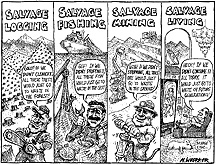By Georgi Page
Free Press contributor
A grassroots Marine Waters and Salmon Habitat Protection initiative awaits the mandate of Washington voters to make it to the 1997 Legislature.The initiative, supported by a coalition of citizen groups called the "Campaign for Marine Waters," seeks to protect Puget Sound and coastal waters from oil spills and to provide for salmon habitat protection and restoration. By January, 225,000 signatures are needed on the petition. That would allow Initiative 188 to be forwarded to the 1997 legislative session.
"Puget Sound is seriously at risk" said Mike Sato of People for Puget Sound, one of the groups involved in the campaign. "With the situation this critical, it's time to make people accountable for salmon protection and to legislate the means to put plans into action."
Initiative 188 proposes to protect Washington's Marine Waters against oil spills by making sure that protection programs are fully funded and ensuring that state and local governments comply with water quality plans. The initiative addresses salmon habitat concerns through greater citizen stewardship of preservation programs and incentives for land owners to protect and restore critical lands.
To guard against oil spill prevention, the measure calls for an independent program which would be fully funded by a tax on oil shipments. The measure also calls for a permanent ban on offshore drilling (last year's House session imposed a five-year moratorium), and a fully funded, independent Puget Sound Water Quality Authority.
Salmon habitat protection and restoration is an emphasis of the Campaign. It hopes to see other counties duplicate property tax incentives like the ones administered by the Waterways 2000 Pilot Project. This project, which was spearheaded by King County Council member Larry Phillips, has raised public consciousness with its "Education rather than Regulation" ethos. By holding public meetings to educate communities about the risks to salmon in their areas, and offering property tax incentives to landowners who restore watershed salmon in their areas, as well as outright purchase of critical property, they have managed to bring 1500 acres of land into conservation.
"Salmon are such an important symbol for this region," said Brindell Swift, of Waterways 2000. "Focusing on their habitat preservation is one way that Councilman Phillips has tried to address the challenge of maintaining a balance between increasing urbanization and our region's unique natural resources."
 --Is it any cleaner up here?
--Is it any cleaner up here?
The Campaign for Marine Waters is still seeking volunteers to help circulate its petition. Contact the Campaign at PO Box 610, Seattle, WA 98111-0610, or call (206) 623-7527.

Taming the Auto, Reclaiming the City
Northwest Environment Watch (NWEW) was formed in 1993 to illuminate broader trends often missed in the rough-and-tumble of everyday political debate. NWEW's latest report, The Car and the City, written by NWEW director Alan Durning, documents the connection between auto dependence, sprawl, and environmental and social deterioration. The report challenges current planning practices, and proposes ideas for a saner path.
The Car and the City debunks the notion that our appetite for asphalt results solely from consumer demand. The paving over of North America, and the US in particular, was the result of policy choices, often heavily influenced by industry. In the 1920s the auto, oil, and tire companies pushed local governments to endorse buses and cars over trains. The postwar explosion of the interstate highway system created arteries that fed strip developmen, sprawling grinds and low-density suburbs.
Federal "urban renewal" policies, combined with freeways and federal home mortgage rules that made high-density housing harder to finance, ensured that owning a car was no longer a choice but a necessity.
Auto-oriented sprawl continues to trump environmentally-sound planning. Seattle's land area grew twice as fast as its population between 1970 and 1990. Even Portland, with its tradition of comprehensive planning, is rapidly consuming its surrounding farmland.
The Car and the City also contains inspirational accounts of attempts to take back the cities for people. It begins with a vignette about life in West Vancouver, where a ramshackle warehouse district has been converted into a pleasant, pedestrian-friendly neighborhood. Vancouver and its suburbs have 45 percent of its land area in medium- to high-density development suited to mass transit or walking, compared to 11 percent in greater Portland and 9 percent in greater Seattle. Vancouver's higher density means that more people use mass transit, allowing the city to recover half of the cost of bus service through fares, compared to less than a quarter in Seattle and Portland.
Portland's popular MAX light rail system created a magnet for high density housing. Washington's Commute Trip Reduction Law, which requires many businesses to encourage carpooling and transit use, reduces auto traffic by 120,000 cars each day. Durning proposes other policy changes, ranging from pay-at-the-pump auto insurance, to the elimination of the home mortgage deduction, that will raise the costs of driving and sprawl.
If high density neighborhoods were built, would people live in them? Durning notes that surveys show that one-third of people living in low density Seattle-area neighborhoods would choose higher-density living if such neighborhoods were available and safe. Successful projects illustrate that quality of life and density are compatible. Would you rather live in low-density Los Angeles, or in high-density Paris? The Car and the City deftly lays out needed changes and provides ideas to help make them happen.
The Car and the City is available from NWEW, 1402 Third Avenue, Suite 1127, Seattle, WA 98102; (206)447-1880; nwwatch@igc.acp.org.
WFP's Interview with NWEW's Alan Durning
and...
"The Consequences of a Cup of Coffee"
(co-written by Alan Thein Durning)
Surprise! Hanford Waste Tanks Leak
Two local public interest groups that monitor the Hanford Nuclear Reservation released new information last month proving that nuclear waste from waste tanks on the site is leaking into ground water underneath the tanks. The 177 tanks at the site contain 56 million gallons of high-level nuclear waste.
Gerald Pollet, executive director of Heart of America Northwest, and Tom Carpenter, director of the Government Accountability Project Seattle office, presented evidence from one of DOE’s own contractors that extremely high levels of Cesium-137 have been found beneath the Hanford tank farms.
The revelations caught the Department of Energy (DOE) off guard as it unveiled a draft of its $7.3 million Environmental Impact Statement (EIS) which outlines various alternatives for handling the tank waste. Evidence that the tanks are now leaking was conspicuously absent from the EIS. Instead, DOE’s study claims it will take 140 years for tank wastes to reach the water table and and the study proposes a number of 'alternatives' for handling the waste, including one which would leave 75 percent of the waste behind.
Pollet blasted the EIS at a press conference and at a Seattle public hearing, charging that DOE is covering up a 'tidal wave of contamination barreling towards the groundwater.' In addition, Pollet noted that a DOE plan to 'sluice' tank waste using high pressure water streams would only drive existing contamination further into the groundwater and the nearby Columbia River.
Pollet and Carpenter presented a dramatic video representation which showed vast plumes of concentrated radioactive materials in the soil several hundred feet beneath the tank farm.
DOE responded that it did disclose the fact that the tanks leak, citing to several sentences in the six-volume EIS. Although the document refers to Cesium contamination below the tank farm, the EIS states, 'The cause of this contamination is unclear and additional characterization and analysis is necessary to determine how these results may change future predictions on the rate of contamination transport...'
Carpenter, an attorney who represents Hanford whistleblowers, said that technicians who are researching the true extent of contamination at the tank farms are once again under attack for their revelations by Hanford 'old guard' managers.
"It's business as usual at Hanford, despite a supposed new era of enlighted management," said Carpenter.
Carpenter charged that DOE managers at the site have been maneuvering to displace two well-known whistleblowers who are now working on monitoring the ground beneath the tank farms.
John Brodeur, who now conducts soil testing at the tank farm, was fired in 1992 after he blew the whistle on the failure to monitor and detect tank leaks.
Casey Ruud, a celebrated Hanford whistleblower, also works at the tank farms as a State environmental specialist on loan to DOE. (Ruud recently received a 'Moral Courage' award from the Cavallo Foundation for his previous whistleblowing activities in the late 1980s at Hanford, which led to the shutdown of dangerous and environmentally destructive facilities.)
In a statement, DOE manager John Wagoner defended his tank managers and said the source of the Cesium contamination was still being evaluated.
To see 'dirty pictures' on Hanford tank wastes, and to learn more about Hanford whisteblowers, visit the Government Accountability Project homepage.
 |
 |
 |
 |
 |
Contents on this page were published in the July/August, 1996 edition of the Washington Free Press.
WFP, 1463 E. Republican #178, Seattle, WA -USA, 98112. -- WAfreepress@gmail.com
Copyright © 1996 WFP Collective, Inc.
